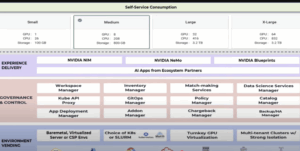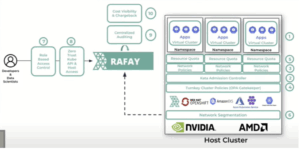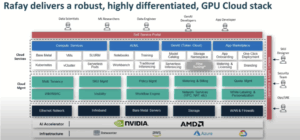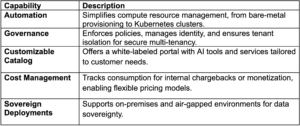
The conversation around AI infrastructure is often dominated by hardware, specifically GPUs. While essential, this focus misses a larger, more critical point: hardware alone is not enough. The challenge, and the real opportunity, lies in bridging the vast gap between renting raw GPU power and delivering a true, self-service AI cloud experience.
At AI Infrastructure Field Day 3, Rafay CEO Haseeb Budhani outlined why providers must transition from GPU-as-a-Service to AI cloud. He also explains how Rafay’s platform bridges this gap by offering automation, governance, and cost-effective solutions tailored for AI infrastructure.
The Problem with “GPU-as-a-Service”
Many GPU providers and enterprises are discovering that simply offering “GPU-as-a-Service” is not a sustainable business model. The margins are thin, and the operational overhead is immense. To truly compete and thrive, they need to emulate the hyperscalers by providing a seamless, application-centric platform that empowers developers and simplifies consumption.
Imagine you need to consume an AI model for a new travel app. You could pay a major cloud provider $7/hour for a managed service or rent an H100 GPU for $1.60/hour. On the surface, the second option seems far cheaper. So why is everyone not just renting raw GPUs?
The answer is complexity. The price difference between raw hardware and a managed service represents the immense effort required to turn a GPU into a usable product. This gap includes:
- Operational Overhead: Managing bare metal servers, networking, and security requires specialized expertise.
- Lack of Self-Service: Developers face ticket-based systems and manual provisioning, stifling innovation.
- No Application Layer: Tools like Jupyter notebooks or AI models aren’t included, requiring additional effort to build and maintain.
What Defines a True AI Cloud?
A true AI cloud must deliver a seamless, self-service experience, robust multi-tenancy, and an application-centric approach to simplify infrastructure complexity. This transition is less about the hardware and more about the operational model built on top of it.
1. True Self-Service Consumption
A developer or data scientist should be able to log into a portal, select the resources and tools they need, whether it’s a single GPU-powered VM, a Kubernetes cluster, or an AI model endpoint and get access within minutes, not days.
This requires automating everything from user authentication and resource provisioning to networking and security policy enforcement.
2. Robust Multi-Tenancy and Governance
In a shared environment, robust multi-tenancy is essential to ensure security, scalability, and cost control. Key features include:
- Network Segmentation: Isolate tenant traffic using overlays and advanced networking techniques.
- Resource Quotas and Policies: Enforce limits on compute, storage, and GPU usage to prevent resource abuse.
- Identity Federation: Integrate with identity providers (e.g., Azure AD) to securely manage access for thousands of users.
3. An Application-Centric Catalog
Developers don’t want to think about infrastructure; they want to solve problems. A real AI cloud offers a catalog of ready-to-use applications, tools, and services, such as:
- Pre-configured Jupyter notebooks
- One-click deployments of popular AI frameworks like QFlow
- Inference endpoints for models like Llama 3 or DeepSeek
The goal is to abstract away complexity. Developers simply need an endpoint, while the platform handles infrastructure, model deployment, and accessibility.
Building this stack from scratch is daunting, requiring years and a massive engineering team. This is where Rafay’s platform comes in.
Building Your AI Cloud with the Rafay Platform
Rafay provides a comprehensive platform to help GPU providers and enterprises build and operate AI clouds. Key capabilities include:
How Rafay Delivers 20x Cost Savings for AI Cloud Solutions
One enterprise saved $5 million over three years by replacing an OpenAI contract with an open-source model deployed on Rafay’s platform. The cost? Just $280,000—a 20x reduction. This highlights the economic incentive of moving from raw hardware to managed services.
Stop Renting and Build an AI Cloud with Rafay
The future belongs to those who can deliver seamless, cost-effective AI cloud experiences. For enterprises, this means empowering developers and controlling costs. For GPU providers, it means evolving into high-margin service providers. With Rafay, organizations can accelerate their journey, unlock new revenue streams, and gain a competitive edge in the AI landscape.
Be sure to watch the Rafay presentations on the Tech Field Day website.





